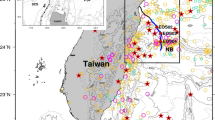Abstract
We investigated the correlation between coastal and offshore tsunami heights by using data from the Dense Oceanfloor Network for Earthquakes and Tsunamis (DONET) observational array of ocean-bottom pressure gauges in the Nankai trough off the Kii Peninsula, Japan. For near-field earthquakes, hydrostatic pressure changes may not accurately indicate sea surface fluctuations, because ocean-bottom pressure gauges are simultaneously displaced by crustal deformation due to faulting. To avoid this problem, we focused on the average waveform of the absolute value of the hydrostatic pressure changes recorded at all the DONET stations during a tsunami. We conducted a Monte Carlo tsunami simulation that revealed a clear relationship between the average waveforms of DONET and tsunami heights at the coast. This result indicates the possibility of accurate real-time prediction of tsunamis by use of arrays of ocean-bottom pressure gauges.






Similar content being viewed by others
References
Allen SCR, Greenslade DJM (2010) Model-based tsunami warnings derived from observed impacts. Nat Hazard Earth Syst Sci 10:2631–2642. doi:10.5194/nhess-10-2631-2010
Baba T, Cummins PR (2005) Contiguous rupture areas of two Nankai earthquakes revealed by high-resolution tsunami waveform inversion. Geophys Res Lett 32:L08304. doi:10.1029/004GL022320
Baba T, Tanioka Y, Cummins PR, Uhira K (2002) The slip distribution of the 1946 Nankai earthquake estimated from tsunami inversion using a new plate model. Phys Earth Planet Inter 132:59–73
Baba T, Hirata K, Kaneda Y (2004) Tsunami magnitude determined from data of ocean-bottom pressure gauges around Japan. Geophys Res Lett 31:L08303. doi:10.1029/2003GL019397
Baba T, Takahashi N, Kaneda Y, Inazawa Y, Kikkojin M (2013) Tsunami inundation modeling of the 2011 Tohoku earthquake using three-dimensional building data for Sendai, Miyagi Prefecture, Japan. In: -Fandiño VS (eds) Tsunami events and lessons learned; ecological and societal significance, Springer, Amsterdam, accepted
Cabinet office panel, government of Japan (2012) The 2nd report of the possible mega earthquake in the Nankai trough (in Japanese), http://www.bousai.go.jp/jishin/chubou/nankai_trough/nankai_trough_top.html
Eguchi T, Fujiwara Y, Fujita E, Iwasaki S, Watanabe I, Fujita H (1998) A real-time observation network of ocean-bottom seismometers deployed at the Sagami trough subduction zone, central Japan. Mar Geophys Res 20:73–94
Fukao Y (1979) Tsunami earthquake and subduction processes near deep-sea trenches. J Geophys Res 84:2303–2314
Furumura T, Imai K, Maeda T (2011) A revised tsunami source model for the 1707 Hoei earthquake and simulation of tsunami inundation of Ryujin Lake, Kyushu Japan. J Geophys Res v116:B02308. doi:10.1029/2010JB007918
Geist EL (2000) Origin of the 17 July 1998 Papua New Guinea tsunami: earthquake or landslide? Seismol Res Lett 71:344–351
Hayashi Y (2010) Empirical relationship of tsunami height between offshore and coastal stations. Earth Planets Space 62:269–275
Hoshiba M, Ozaki T (2012) Earthquake early warning and tsunami warning of JMA for the 2011 off the Pacific Coast of Tohoku earthquake(in Japanese with English Abstract). Zisin 64:155–168
Ishibashi K, Satake K (1998) Problems on forecasting great earthquakes in the subduction zones around Japan by means of paleoseismology (in Japanese). J Seismol Soc Jpn Zisin 50:1–21
Japan Agency for Marine-Earth Science and Technology, Start of real-time monitoring through submarine cable network by the long-term borehole observatory installed by the Deep Sea Drilling Vessel Chikyu., Press Release by http://www.jamstec.go.jp/e/about/press_release/20130205/, 2013
Kamigaichi O (2009) Tsunami forecasting and warning. In: Meyers RA (ed) Encyclopedia of complexity and systems science. Springer, Heidelberg, pp 9592–9618
Kanamori H (1972a) Mechanism of tsunami earthquakes. Phys Earth Planet Inter 6:346–359
Kanamori H (1972b) Tectonic implications of the 1944 Tonankai and the 1946 Nakaido earthquakes. Phys Earth Planet Inter 5:129–139
Kato T, Terada Y, Kinoshita M, Kakimoto H, Isshiki H, Matsuishi M, Yokoyama A, Tanno T (2000) Real-time observation of tsunami by RTKGPS. Earth Planets Space 52:841–845
Lauterjung J, Münch U, Rudloff A (2010) The challenge of installing a tsunami early warning system in the vicinity of the Sunda Arc Indonesia. Nat Hazards Earth Syst Sci 10:641–646. doi:10.5194/nhess-10-641-2010
Momma H, Fujiwara N, Iwase R, Kawaguchi K, Suzuki S, Kinoshita H (1997) Monitoring system for submarine earthquakes and deep sea environment. Proc MTS/IEEE OCEANS’97. 2:1453–1459
Percival DB, Denbo DW, Eble MC, Gica E, Mofjeld HO, Spillane MC, Tang L, Titov VV (2011) Extraction of tsunami source coefficients via inversion of DART® buoy data. Nat Hazards 58:567–590. doi:10.1007/s11069-010-9688-1
Satake K, Kato Y (2001) The 1741 Oshima–Oshima eruption: extent and volume of submarine debris avalanche. Geophys Res Lett 28:427–430
Tanioka Y, Seno T (2001) Sediment effect on tsunami generation of the 1896 Sanriku tsunami earthquake. Geophys Res Lett 28:3389–3392
Tappin DR, Watts P, McMurtry GM, Lafoy Y, Matsumoto T (2001) The Sissano, Papua New Guinea tsunami of July 1998—offshore evidence on the source mechanism. Mar Geol 175:1–23
Titov VV, Gonzalez FI, Bernard EN, Eble MC, Mojfeld HO, Newman JC, Venturato AJ (2005) Real-time tsunami forecasting: challenges and solutions. Nat Hazards 35:35–41. doi:10.1007/s11069-004-2403-3
Tsushima H, Hino R, Fujimoto H, Tanioka Y, Imamura F (2009) Near-field tsunami forecasting from cabled ocean bottom pressure data. J Geophys Res 114. doi:10.1029/2008JB005988
Tsushima H, Hirata K, Hayashi Y, Tanioka Y, Kimura K, Sakai S, Shinohara M, Kanazawa T, Hino R, Maeda K (2011) Near-field tsunami forecasting using offshore tsunami data from the 2011 off the Pacific coast of Tohoku Earthquake. Earth Planets Space 63:821–826
Utsu T (2001) Seismology, 3rd edn. Tokyo, Kyoritsu Pub, p 376 (in. Japanese)
Acknowledgments
We thank Dr. Shu-Kun Hsu for editing and two anonymous reviewers for their careful reviews of this paper. We also thank Dr. Fumihiko Imamura and Mr. Masayuki Okuno for providing the digital elevation model data for the Owase and Kumano regions. The 2011 Tohoku tsunami data for the GPS buoy were provided by the Ministry of Land, Infrastructure, Transport and Tourism, and tide-gauge data from the tsunami were provided by the Japan Meteorological Agency. This study was partially supported by SATREPS (Science and Technology Research Partnership for Sustainable Development).
Author information
Authors and Affiliations
Corresponding author
Rights and permissions
About this article
Cite this article
Baba, T., Takahashi, N. & Kaneda, Y. Near-field tsunami amplification factors in the Kii Peninsula, Japan for Dense Oceanfloor Network for Earthquakes and Tsunamis (DONET). Mar Geophys Res 35, 319–325 (2014). https://doi.org/10.1007/s11001-013-9189-1
Received:
Accepted:
Published:
Issue Date:
DOI: https://doi.org/10.1007/s11001-013-9189-1




